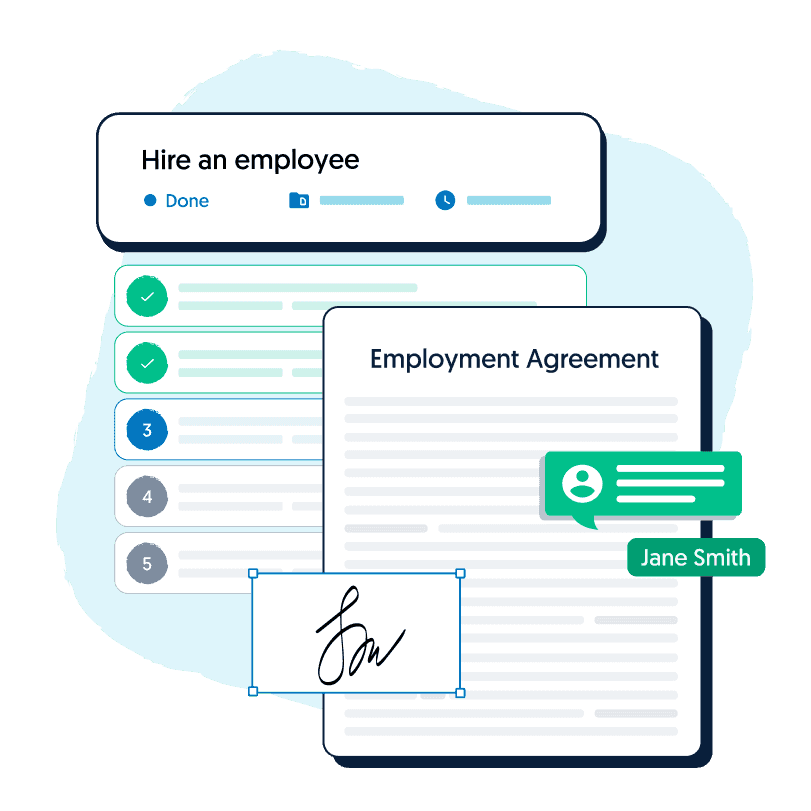Hiring your first employee in California is an exciting milestone and a great sign that your business is on track. What better place to hire an employee than in California, the land of endless and exciting business opportunities!
However, before you start hiring new employees, it’s essential to understand the different legal requirements and steps involved.
Recruiting the right way will save you the hassle of addressing any legal obstacles and business costs down the track regardless of whether you are hiring your first employee in California or your fiftieth.
To ensure that doesn’t happen, the following steps will explain how to hire an employee successfully in California.
Want to learn more?
Read along.
Table of Contents
Section 1: Before you hire your new employee in California
Before you hire your first employee, there are a few legal and business steps that you need to complete to ensure the hiring process is smooth. Let’s look at the steps you’ll need to take.
1. Apply for an Employer Identification Number
Before hiring an employee in California, you need to apply and register as a business and an employer in California by applying for an Employer Identification Number (EIN) using form SS-4 from the IRS.
The EIN is a 9-digit number assigned to all types of business owners, including:
- Employers
- Sole proprietors
- Corporations
- Partnerships
- Estates
- Trusts
Applying for an EIN will ensure that you are legally compliant in the state of California, as you will be subject to employment tax laws once you hire an employee. Having an EIN will also ensure that you can legally file your taxes, reporting obligations, and other business paperwork.
The California Employment Development Department also requires that you register for an unemployment number and an Employer Account Number when you have one or more employees.

Are you looking to hire an employee?
Use our "Hire an employee" workflow to complete and check off all your legal requirements
2. Make a plan: Employee or contractor
Before you do anything, you need to first figure out whether you want to hire an employee or an independent contractor. Although they might sound the same, there are a few differences to be aware of as this will impact your legal obligations as an employer.
Employee
In general, an ‘employee’ works for an ‘employer’ and provides services in return for a wage. The employer-employee relationship is fundamentally a ‘contract of service’, where the employee provides exclusive services to an employer and also at the discretion of the employer.
Employees also tend to keep regular hours and work on a consistent basis. Full and part-time employees can take annual and sick leave. Further, when an employee leaves the job they need to provide notice and work through that period.
To summarize, if you hire an employee the following will apply:
- The employee will be on your business’s payroll
- The employee will need to abide by your business guidelines
- Entitled to employee benefits such as overtime
- The employee will have meal and rest break requirements
- You must withhold appropriate taxes
Contractor
By contrast, an ‘independent contractor’ is a ‘contract for service’. This is because the contractor is part of an independent business with an obligation to provide goods and/or services for a price.
Independent contractors often work for themselves and receive payment on a fixed basis. Contractors have the freedom to choose their own hours so long as they complete the terms of the contract, but can be terminated without notice.
If you choose to hire a contractor, you will not need to provide benefits such as:
- Health insurance
- Paid time off
- Taxes – A contractor is responsible for paying their own taxes
3. Understand California labor laws
It’s important to research California labor laws and hiring guidelines before you start posting jobs and scheduling interviews.
Employment laws to be aware of include:
- Family Medical Leave Act (FMLA) – The FMLA is a federal labor law that allows employees to take an extended leave of absence from work. Leave may be granted for illness, birth or adoption of a child or military or emergency-related services.
- Fair Labor Standards Act (FLSA) – The FLSA establishes laws regarding minimum wage, overtime pay, record-keeping and youth employment standards.
- Wage Theft Prevention Act (WTPA)– The WTPA will require you to provide all future employees with information relating to
- Rates and salary
- Pay type
- Overtime
- Allowances
- Annual notices
- Compensations
- Other terms of their employment contract
- California Fair Employment and Housing Act (FEHA) – The FEHA is the primary law in California that protects employees against harassment, retaliation and discrimination in the workforce.
By educating yourself on these important legislative provisions, you can create job openings enticing potential employees while ensuring that you are legally compliant. If you want to ensure that you’re always up-to-date with California Labor, you can visit the Department of Labor website.
Section 2: The hiring process
Hiring an employee in California can be a competitive process, with many other small businesses also wanting to hire the best staff. With this in mind, your business’s job opening needs to be marketed the right way to attract the best talent.
Let’s go through the key steps required in the hiring process.
1. Recruitment
If you decide on hiring an employee, the next step is to promote the position through a position/job title. A position description or ‘PD’ provides prospective candidates with an overview of the role and its responsibilities and can include a selection criteria and information about remuneration.
The information from this form will help you to compare and contrast each applicant to make a more informed decision. Moreover, once you’ve chosen the applicant, you won’t need to chase after their personal and professional information.
This will also help retention in that it will ensure that the individual you pick is right for the role and will fit in with their new co-workers.
2. Background Check
As an employer, you are able to gather background information of the applicant to ensure they are the right person for the role. Similarly, a credit check can be supplemental and conducted for certain positions only if the applicant has been given notice and explanation.
However, when conducting this check it is important to not take into consideration sexual orientation, age, religion, race, gender, or disability as it is a form of illegal discrimination even if you are just hiring your first employee in California. This is to ensure you comply with the California Fair Employment and Housing Act (FEHA).
Additionally, the Fair Chance Act, also known as ‘Ban the Box’, is intended to ensure that workers with prior convictions are given fair consideration for jobs. Therefore, as a Californian employer, you will not be allowed to ask prospective employees about their conviction history during the job application or run a conviction background check on them until you offer them the job.
3. Drug Testing
When hiring a new employee in California, you, as the employer, are allowed to subject them to drug testing. However, you must give the applicant sufficient notice before undertaking the test.
4. Making an Offer of Employment
A written offer should be made to a prospective employee after an effective job application. A new employee should also sign an employment contract which will confirm that they agree to the employment terms.
A written offer should include the date the job commences, the position, information regarding wages, onboarding requirements and also include any other aspects of the employment relationship.
Summary checklist
Now that you have a good understanding of the key steps, here is a quick and easy checklist to use to ensure you’re recruiting the right way.
- Evaluate which positions you need to fill – This step ensures you’re employing someone to fill a specific need in your business.
- Best recruitment strategy – Consider how you will recruit your employee. Will it be through your business’s website, Linkedin, social media or through an agency?
- Follow California hiring guidelines – California has specific hiring guidelines under the Fair Employment and Housing Act, which prohibits discriminatory hiring practices. This Act applies to employers with five or more employees.
- Job descriptions – A good job description will be appealing to potential candidates. Think about including information about your business’s culture, job requirements, responsibilities and expectations.
- Interview the most qualified candidates – You should only interview the most qualified candidates, so you aren’t wasting valuable business hours.
- You’re ready to hire – Once you’ve chosen your perfect candidate, you should provide them with an offer letter that outlines the terms of the employment, duties, start date, wage or salary, benefits, and at-will employment status.
Now that you’ve hired your perfect employee, let’s get into what comes next to ensure you’re continuing to adhere to California laws.
Section 3: After you hire your employee
Once you hire your employee, there are certain legal standards and obligations that you need to abide by in California. Let’s go through them.
1. New hire forms and documents in California
Once you hire your employee, there are certain legal standards, documents and forms that your employee needs to fill out. These forms are to be provided to your employee during the onboarding process and are a mixture of state law and federal law requirements.
Employee Information Form
The employee information form allows you to gather personal and emergency information from your new employee. You need to collect the following information:
- Full name
- Mailing address
- Phone number
- Email Address
- Emergency contact information
- Starting salary and job title
This form should be kept in a safe place and can be used for performance evaluations, references and in cases of emergencies.
Form I-9 Employment Eligibility Verification
For each new employee, Form I-9 must be completed to examine identity and employment eligibility. This is to verify that the individual is who they say they are. Acceptable forms of verification include social security, passport and driver’s license.
Form I-9 must be completed and held by the employer for three years or one year after the date of employment termination. The form has two key components:
- Section 1 – This section must be filled out by your employee on their first day of work. They need to provide their driver’s license, passport or Social Security card.
- Section 2 – Section 2 requires you to confirm and verify your employee’s information. Verification means checking that the documents provided by your employee are not expired.
Once you and your employee fill out the 1-9 form, you need to keep it on file.
Notices required by law
Every new employee must be provided with the following notices:
- Notice of Rights of Victims of Domestic Violence, Sexual Assault and Stalking. A template notice may be found at dir.ca.gov.
- For non-exempt employees, a Wage Theft Prevention Act notice. A template notice may be found at dir.ca.gov.
Employee handbook
An employee handbook is a valuable resource that ensures your new employee is aware of the rules and expectations of your business. Your new hire needs to be provided with a copy of the employee handbook in the first week of work.
Whether you have an existing employee handbook or need to create a new one, it should cover the following employment policies and pamphlets:
- Employee Privacy Policy
- Social Media Policy
- Surveillance Policy
- Leave Policy
- Sexual Harassment Pamphlet (DFEH-185P)
- EDD Disability Insurance Pamphlet (Form DE 2515)
- Paid Family Leave Pamphlet (Form DE 2511)
- Wage and Employment Notice to Employees (Labor Code section 2810.5) (Form DLSE-NTE).
- New Health Insurance Marketplace Coverage Options and Health Coverage Form (Form OMB No. 1210-0149)
- Rights of Victims of Domestic Violence, Sexual Assault and Stalking Pamphlet
- Work Permit for Minors (if applicable) (CDE Form B1-4)
To ensure your new employee has read the handbook, organize a follow-up session to discuss any questions or concerns.
Other employer-specific requirements or documents
Other employer-specific documents that you may need to provide include:
- Arbitration agreement – An arbitration agreement is a legally binding contract that offers an alternative dispute resolution between parties in the workplace.
- Orientation/training documents – Orientation and training documents will help your new employees start on the right foot and improve productivity.
- Confidentiality/non-disclosure agreement – A Confidentiality Agreement is a legal document that you can use to disclose private or sensitive information to your employee while legally forbidding them from disclosing that information to any other person or entity.
- Direct deposit form – A direct deposit form will allow you to send money to your employee’s bank account.
- Notice of Rights of Victims of Domestic Violence, Sexual Assault and Stalking – This form needs to be provided to all new and existing employees when they request it.

2. New hire reporting in California
Once you hire a new employee in California you need to notify the New Employee Registry within 20 days of their start-of-work date. The report needs to include information about you and your new employee. Information about your new employee includes their:
- Social Security number
- Full name
- Date of birth
- Address
- Start-of-work date
You will also need to provide the following information:
- California employer payroll tax account number
- Federal Employer Identification Number
- Business name
- Address
- Contact phone number
Once you have completed the new hire reporting form, you can submit the form electronically by filing a DE34 form in relation to the new employee with the California Business e-Services.
Alternatively, you can head to the post office and mail a completed DE 34 “Report of New Employee” form or W-4 form to the following address.
Employment Development Department
Document Management Group, MIC 96
P.O. Box 997016
West Sacramento, CA 95799-7016
3. Payroll in California
After hiring an employee in California, you become subject to employment tax laws.
This includes federal income tax withholding, state income tax withholding, social security, Medicare and unemployment insurance benefits.
Here is a list of all the relevant forms related to your taxing obligations as an employer.
Form DE4
You will have to register with the Employment Development Department (EDD) to obtain a state identification number (federal tax identification number equivalent).
To obtain this number you will need to file a DE-1 form to register with the EDD. Similarly, a Form DE4 is required to be submitted to determine state income tax withholding. This allows for Social Security and Medicare as per the Federal Insurance Contributions Act (FICA).
Form W-4 Federal Income Tax Withholding
W-4 Form in California is to be provided to your employees so they can indicate how much income tax they wish to withhold from each of their paychecks. You need to ensure your new employee provides you with this form by the first week of their employment.
Form W-2
Form W-2 is a form that outlines the income your employees earn, the amount of taxes that are withheld from their paycheck and other important information that is used for federal and state taxes. You need to provide this form to your employees as soon as they begin so they can use the form when preparing their tax returns.
Form 941
You are to use this Form 941 to report on income taxes, social security tax, or Medicare tax withheld from your new employee’s paycheck. This is due quarterly.
Form 940
You are required to use Form 940 to report on your annual Federal Unemployment Tax Act tax annually.
Summary
As a small business owner, it’s important to monitor and review any changes to state guidelines. You can use the IRS website to find out when and why you must file these forms to ensure you don’t miss any deadlines.
4. Workers’ compensation insurance coverage
Once you hire an employee in California, you must provide workers’ compensation insurance or receive state approval to self-insure your new employees with the required benefits.
As an employer in California, the purpose of workers’ compensation is to ensure:
- Your employees are entitled to medical treatment for on-the-job injuries.
- If your employees fall ill, they will be covered – medical care, temporary and permanent disability benefits, and death benefits.
- Both you and your employees will be covered no matter who is at fault.
Are you required to have workers’ compensation in place even if you only have one employee? The short answer is yes.
As an employer, whether you hire one of five employees, if you don’t provide workers’ compensation insurance or do not receive state approval to be self-insurance, you could be subject to criminal and civil penalties.
5. Maintaining an employee file
California law requires you to keep several items in your new employee’s employment file. This includes:
- Tax forms
- Verification of eligibility to work
- Benefits forms
- Withholding agreements
- Performance evaluations
Additionally, the Californian government code 12946 requires employees to maintain for four years records of:
1. Employee applications.
2. Employment referral records and files.
4. Personnel files of all applicants.
5. Information about applicants’ race, sex, and national origin.
It is good practice to maintain such records in case the hiring process is later called into question.
Section 4: Ongoing Obligations
Once you hire your new employee, you have ongoing obligations to ensure you’re legally complying with the California laws. This includes making sure that you’re offering your new employee all the employee benefits they are entitled to.
You, as the provider, can set out employee benefits in an Employment Contract. When hiring a new employee in California you have to make sure that your employment practice is in line with FEHA and human resources.
Here is everything to be aware of.
Pregnancy
Under FEHA, employers need to provide reasonable accommodations for individuals who are pregnant or have recently had a child.
Disability
As an employer, you need to make sure that individuals with disabilities are catered for and that there is sufficient accommodation for their needs within the workplace.
Pay
FEHA requires equal pay and ensures that monetary discrimination within the workplace does not occur. Similarly, an employer cannot prohibit the discussion of employee wages or limit access to personnel files.
Wage
Depending on the size of your business the minimum wage can differ. If you have fewer than 25 employees, $14/h is the minimum, however, if you have 26 or more employees then $15/h is the minimum. Similarly, whether an individual is working full-time or part-time will impact how their wage is assessed.
Another important consideration is overtime. California law requires an employer to pay overtime for employees who work more than 40 hours per week. This will be one and a half times the employee’s ordinary hourly wage.
Breaks
In California, an employee is entitled to a 10-minute break for every four hours of work. Similarly, a meal break is required to be at a minimum of 30 minutes.
Temporary Disability Health Insurance
This Californian program administered by the Employment Development Department (EDD) is a government agency that provides partial wage replacement if an individual is unable to undertake their usual tasks due to a non-work-related illness or injury.
Health Care
As an employer, you are required, by the California Continuation Benefits Replacement Act to have group health plans offering continuation coverage to qualified beneficiaries.
Leave
Under the California Family Rights Act (CFRA), you are required (if you have more than 5 employees) to provide up to 12 weeks of job-protected leave in a 12-month period if the employee or close family member has a serious health condition, they are fostering a child or are required to partake in active duty.
Additionally, paid sick leave is mandated as per the Healthy Workplaces, Healthy Families Act (HWHFA). Employees have access to 24 hours or 3 days of sick leave per year. Employees are eligible for sick leave if; they need treatment for an existing health condition, preventative care, or are a victim of assault, violence and stalking.
Frequently Asked Questions
What is an employment agreement?
An employment agreement includes a confidentiality clause that requires an employee not to disclose an employer’s confidential or proprietary information. Information that is “confidential” is unique to a particular company similarly disclosure of such information can harm a business.
What are the important considerations in an employment agreement?
- Confidentiality clauses
- General statement of eligibility for benefits plan
- Non-compete (also known as restraint of trade) clauses
- Rate of pay
- Severability clause
- Specified probationary period
- Starting date
- Statement of at-will nature of employment
- Title of the position being offered
- Any other state, industry-specific, or company-required information
- A statement indicating that there are no agreements between the parties other than those explicitly stated within the agreement
Key takeaways
The hiring process is ongoing, and each time you onboard a new employee, it’s critical to check California and federal guidelines to comply with the latest regulations.
We understand that there’s a lot to keep track of when hiring a new employee in California, so we’ve summarized for steps for you when hiring an employee:
- Step 1: Before you hire your new employee in California
- Step 2: The hiring process
- Step 3: After you hire your employee
- Step 4: Ongoing obligations
If you’re ready to hire an employee in California, why not check our Lawpaths legal documents to ensure a smooth hiring process.

Get a free legal document when you sign up to Lawpath
Sign up for one of our legal plans or get started for free today.




